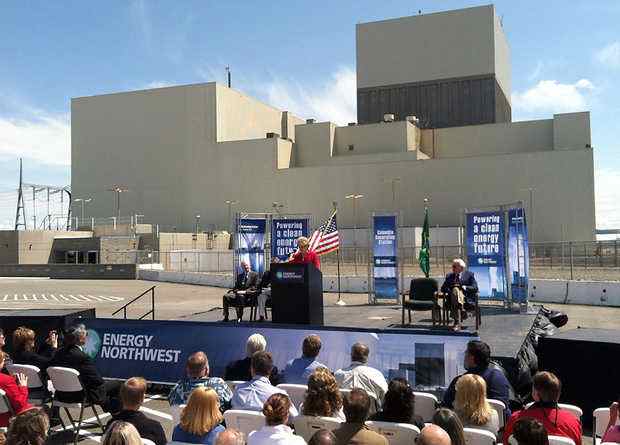forum
library
tutorial
contact

Nuclear Power: A Risky
Wager for the Northwest
by Bruce Amundson and Chuck Johnson
Crosscut, September 11, 2014
|
the film forum library tutorial contact |

|
Nuclear Power: A Risky
by Bruce Amundson and Chuck Johnson
|
Running an aging nuclear power plant and building new ones is a gamble for Washington State.
 Seattle City Light and its fellow publicly-owned utilities continue to operate a nuclear power plant of similar vintage and design as the three reactors that melted down in Japan in 2011. Now they want to double down with a new series of up to 12 "small modular reactors" at Hanford, their answer to the challenge of creating low-carbon electricity. That's a risky bet and a surprising one. The previous wager on nuclear energy in the 1980s led to the largest bond default in U.S. history at the time.
Seattle City Light and its fellow publicly-owned utilities continue to operate a nuclear power plant of similar vintage and design as the three reactors that melted down in Japan in 2011. Now they want to double down with a new series of up to 12 "small modular reactors" at Hanford, their answer to the challenge of creating low-carbon electricity. That's a risky bet and a surprising one. The previous wager on nuclear energy in the 1980s led to the largest bond default in U.S. history at the time.
Northwest ratepayers are still paying for three of the five nuclear power plants begun by publicly-owned utilities through the Washington Public Power Supply System (WPPSS, or "whoops"). That amounts to 35 percent of the Bonneville Power Administration's annual expenses passed on to residential and business customers throughout our region. The one plant that was actually finished provides only 10 percent of Bonneville's electricity.
Given the poor economics and reliability of nuclear projects in the Pacific Northwest it is imperative that citizens and utilities like Seattle City Light and its fellow board members of Energy Northwest -- the former WPPSS was wisely renamed in 1999 -- carefully assess the financial costs and safety risks associated with renewed development of nuclear power.
The NuScale small modular reactors touted by Energy Northwest for our region are not a revolutionary new design. They are, instead, smaller versions of the light water reactor technology most familiar to the nuclear power industry. The problem of how to permanently contain the highly dangerous plutonium waste, along with the radioactive cesium and strontium and other deadly by-products of nuclear fission, remains an unsolved "Achilles heel." These reactors use standard enriched uranium fuel. The process of mining and milling that uranium has severely contaminated lands throughout North America, including the Spokane Indian Reservation in Washington.
At this stage in the design process, the NuScale engineers claim a couple of advantages over the Columbia Generating Station (the former WPPSS #2 reactor), a GE Boiling Water Reactor that Energy Northwest continues to operate on the Hanford Nuclear Reservation:
Even more damaging to the future of small modular reactors are estimates of the actual price of building them. Throughout the world, sticker shock on construction of new full-sized nuclear power plant designs has slowed new purchases of reactors to a trickle. It will be even more challenging to keep costs down in smaller reactors, and overcome the economy of scale issue that has always argued for building commercial nuclear reactors big enough to recoup the expensive construction cost with large scale electricity production when finished.
Editor's Note: This guest opinion is part of an ongoing debate spurred by Crosscut's August 20 story about Seattle City Light's use of nuclear power.
learn more on topics covered in the film
see the video
read the script
learn the songs
discussion forum
